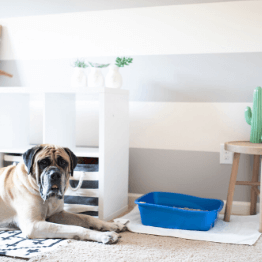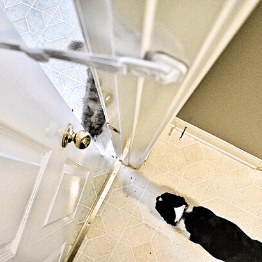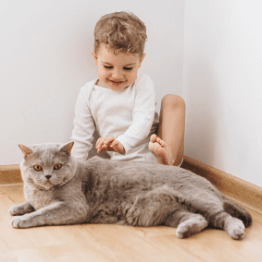ADOPTING A CAT CHECKLIST: THE ULTIMATE GUIDE FOR NEW CAT OWNERS
By: Door Buddy Editors | Published: 11 June 2025

Adopting a cat is an incredibly rewarding experience, but it comes with plenty of questions, especially for first-time cat parents. Whether you’re bringing home a shelter cat, adopting from a rescue, or taking in a stray, preparation is key to helping your new feline feel safe and settled.
This comprehensive adopting a cat checklist is here to guide you every step of the way. From things to consider before adopting a cat to the first week at home, we’ll cover it all, so you can feel confident and your cat can feel right at home.
SECTION 1: PRE-ADOPTION PREP
What to know before adopting a cat
If you’re a new cat owner, you might be wondering where to start. The truth is, what you do before adoption makes a world of difference.
Research First
One of the first things to consider before adopting a cat is breed temperament and care needs. Some cats are independent and quiet, while others are vocal, playful, or require regular grooming. Find your perfect kitty with our 'What Type of Cat Is Best for Me?' blog.

Choose a Vet
Before bringing home an adopted cat, find a trusted vet near you. Book a check-up within the first week to address vaccinations, spay/neuter info, and feeding guidance.
Cat-Proof Your Home
When bringing a new cat home, it’s essential to remove hazards:
-
Tidy away dangling cords
-
Store household cleaners
-
Remove toxic plants like lilies and aloe
-
Create a cozy space with hiding spots
Safe Space = Happy Cat
Before bringing home a rescue cat, set up a quiet, comfortable room with food, water, a litter box, and soft bedding. This will help reduce stress and make the transition easier.
Door Buddy is a great way to give your cat a safe space. It keeps dogs out and creates a little sanctuary just for your kitty!
SECTION 2: CHECKLIST FOR NEW CAT OWNERS
Your first-time cat owner checklist
This essential checklist for new cat owners covers everything you’ll need to welcome your kitty home.
Food & Feeding
-
High-quality dry or wet food (ask your vet for advice)
-
Stainless steel or ceramic food & water bowls
-
Cat treats for bonding and training
Litter Box Essentials
-
1 litter box per cat (plus an extra if possible)
-
Unscented, clumping, natural, cat litter comes in all kinds! Want to know which litter is best for your kitty? Read this blog.
-
Litter scoop and waste disposal system
Comfort & Shelter
-
Soft cat bed or fluffy blanket
-
Hiding spots like cat caves or boxes
-
Cat tree or vertical shelves for climbing
Toys & Enrichment
-
Wand toys, teaser sticks, and catnip mice
-
Puzzle feeders to challenge the brain
-
Scratching posts (both vertical and horizontal)
Health & Grooming
-
Pet carrier for travel and vet visits
-
Cat brush or comb suited to coat type
-
Nail clippers or scratching options
-
Flea treatments and dewormer (vet-recommended)

SECTION 3: EMOTIONAL PREP & FIRST WEEK TIPS
Bringing home a cat? Here’s how to help them settle in
The first week is critical, especially if you're bringing home a shelter cat or rescue cat. Be patient, it takes time to build trust.
Let Them Set the Pace
Don’t force attention. Let your cat explore at their own speed. A hiding cat isn’t scared, it’s just adjusting.
Keep Things Calm
Avoid loud noises, too many visitors, or changes in routine. Cats love stability, especially when bringing home a cat from a different environment.

Watch for Early Signs of Comfort
Some signs a kitten is settling in include:
-
Using the litter box consistently
-
Purring or slow blinking at you
-
Grooming themselves or exploring confidently
Gradual Introductions
If you have kids or other pets, introduce them slowly and with supervision.
Want to learn more about introducing pets to each other? Check out these helpful blog posts:
SECTION 4: BONUS TIPS
Want a fridge-friendly version? Download our free first-time cat owner checklist.
FAQS: QUICK ANSWERS FOR BUSY PET PARENTS
A: It depends! Some cats benefit from companionship, but not all. Ask about bonded pairs.
A: Yes! Senior cats are often calmer and more independent, perfect for quieter homes.
A: Keep the environment calm and quiet. Place them in a single room with their essentials, food, water, litter box, and a cozy bed. Let them explore at their own pace. Don’t try to cuddle them unless they come to you.
A: Introduce them slowly and in a controlled environment. Keep the dog on a leash at first and allow the cat to observe from a safe space. Never leave them alone together until you're sure they’re comfortable.
A: Kittens are energetic and need lots of attention. Adult cats are often more independent and have established personalities, which can make them easier for first-time cat owners.
A: It’s best to wait at least a few weeks and only if the cat is spayed/neutered, vaccinated, and microchipped. Many recommend keeping cats indoors or using a secure catio for safety.
CONCLUSION: ADOPTING A CAT CHECKLIST
Adopting a cat is a big step, but a beautiful one. With the help of our adopting a cat checklist, the right preparation, and plenty of love, you'll be setting your new feline friend up for a happy, healthy life in their forever home.
Looking to adopt a furry friend?
There are so many loving cats, dogs, and other pets waiting for their forever homes. Whether you're searching for a playful kitten, a mellow senior dog, or anything in between, these trusted adoption platforms make it easy to find the perfect match. Start your journey with one of these top pet adoption websites:




